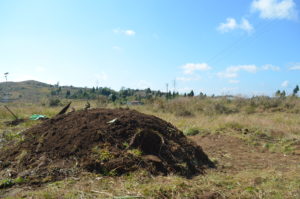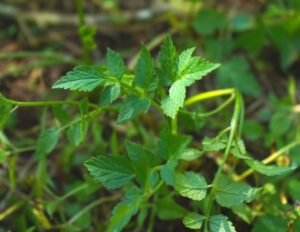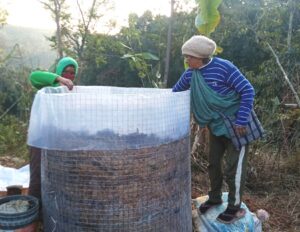
For the last couple of years, a great deal of awareness on health consciousness among the people in Meghalaya, or any other region, has risen. It has led them to insist eating primarily on clean food. Today, most of the food bought from the markets and consumed is a by-product of either commercialised farming (agriculture with fertilisers or other chemicals) or processed foods that are toxic. It is not that consumers are not aware of the fact that it is harmful to one’s health. However, they are motivated to buy for their convenience and they bury away their consciousness within their stomach; knowing the adverse effects on their health only later.

In the race to achieve ‘Good, Clean and Fair food’, farmers play the key role in providing us with clean food. Most of the farmers have easy access to modern day fertilisers and other chemicals to maximise their yields, so they make use of this easy way out to increase the output and create a competitive advantage where possible to be sold in the market.
It is a challenge to change the mindset that lies even among the farmers. There are, however, many substitutes to the use of chemicals, such as organic manures; though they come with a price, the farmers need to have an alternative to sustainably be able to sell their produce.
One of the best ways to empower farmers is to assure them there is another possibility of cultivating their own farm waste through composting. They already have access to abundant agricultural waste surrounding them, which is often neglected by many. “When crop residue is converted into compost, it is as good as gold for the farmers,” said Dr Carl O Rangad, (Vice Chairman Operations, NESFAS).

On the 12th of November, 2016, the community of Laitsohpliah Village, East Khasi Hills District, Meghalaya, hosted a workshop on surface composting organised by NESFAS. Dr Carl O Rangad guided the session where participants from four villages around East Khasi Hills namely, Laitsohpliah, Laitthemlangsah, Nongtraw and Dewlieh took an active part.
The farmers were taught the basics of surface composting by using crop residue and converting it to green gold (organic manure). Surface composting can also be seen as less time consuming and does not involve intricate techniques to learn.
 According to The Wall Street Journal’s article published on the 4th November 2016, titled “What Is Behind Delhi’s Soaring Air Pollution?” The burning of stubble in the paddy fields in the neighbouring states of Punjab, Haryana and Uttar Pradesh was traced to be behind Delhi’s soaring air pollution
According to The Wall Street Journal’s article published on the 4th November 2016, titled “What Is Behind Delhi’s Soaring Air Pollution?” The burning of stubble in the paddy fields in the neighbouring states of Punjab, Haryana and Uttar Pradesh was traced to be behind Delhi’s soaring air pollution
In Meghalaya, excess paddy straw is also burnt, especially in the interior parts of the region like West Garo Hills and West Khasi Hills. Most of our farmers are unaware of the possibilities to convert the agricultural waste into green gold. Even as most of the villages found in Meghalaya have a compost pit or a Liewsboh (in Khasi) where a great number of agricultural waste product is dumped in a pit for decomposition.
According to the Natural Resources Management and Environment Department, FAO, it can take about six to eight months to obtain the finished product in a compost pit. There is a lot of nutrients such as nitrogen, carbon dioxide or methane wasted through leaching by using this method.

The core purpose of practising the use of surface compost is to do away with the extensive usage of fertilisers found in their fields. It has contributed in creating adverse effects to climate change through degrading the soil health and such.
By recycling the agricultural residue through surface composting, agricultural biomass is broken down and converted to compost which can further be used in the fields. It can, act as a supplement and not being looked as a replacement over other available manures completely.
“Surface composting is basic and might only be forty percent efficient, but it is still good enough and better than nothing,” says Dr. Rangad. When farmers are aware of better ways to create an alternative to improve their livelihood, a sense of empowerment is in their hands to provide clean food.

The different Participatory Guarantee System groups who took part in the composting workshop had executed the process themselves. Mr Ness, the headman of Laitsohpliah energised the session through his amusing Phawar (in Khasi) or couplet with ingenious lyrics that intensified the enthusiasm during the compost session.
Kong Byllaimon Swer, a custodian farmer from Laitsohpliah Village, shared that she was taught a similar technique to make compost by her mother when she was young. However, they would use salt in the mixture to speed up the decomposition process. Even as these traditional practices are very much relevant, yet they have slowly perished and have been replaced with the use of urea.
Dr Rangad said, “Seeing is believing and learning by doing is the only slogan of extension that will ensure mobilisation and active participation from villages within our state to make them do away with commercial farming”.
Watch on YouTube




Pingback: “Strengthening Convergences for Empowering Women Farmers in Meghalaya”- Workshop at SIRD - North East Slow Food & Agrobiodiversity SocietyNorth East Slow Food & Agrobiodiversity Society